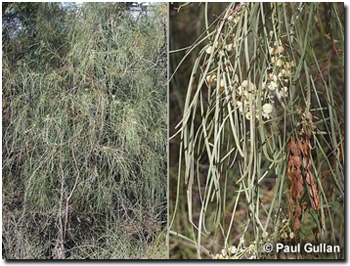Eumong
Back | Salinity Indicator Plants Home | Common name home | Scientific name home | Photo Gallery | Glossary
Family: Wattle (Mimosaceae) |
| Scientific Name: | Acacia stenophylla | |||||||
Status: | Australian native | |||||||
Other Common Names: | River Cooba, River Myall, Belalie, Dunthy, Black Wattle, Dalby Myall, Ironwood, Native Willow, Gurley | |||||||
Plant Description: | Straggly shrub or tree, to 10 m high, with drooping leaves and small branches. Leaves broad-linear, 15 – 40 cm or more long, 3 – 6 mm broad, slightly curved, thick, rigid, striated with 15 – 20 longitudinal veins. Flowers pale yellow, in globular heads 6 – 9 mm diameter which are borne on stalks 6 – 10 mm long in clusters or short racemes of 1 – several heads in the leaf axils, each head composed of 25 – 30 minute individual flowers. Pods 10 – 20 cm long, to 10 mm broad, leathery, rather thick, strongly constricted between the longitudinally arranged seeds. Flowering mostly summer – early autumn | |||||||
Habitat: | On heavy clay soils in River Red-gum (Eucalyptus camaldulensis ) communities along river and creek banks and swamp margins and on islands in rivers and swamps. Also occurs in Black Box (Eucalyptus largiflorens ), and Belah (Casuarina pauper) communities but usually not far away from a river or creek channel. Adapted to saline, alkaline, waterlogged, heavy clay soils in arid and semi-arid regions where groundwater is available.
| |||||||
Comments: | Aboriginals used Eumong wood for clubs and boomerangs and roasted the pods to eat the seeds. It is not normally preferred by livestock but can be good sheep fodder | |||||||
Related Links
- CSIRO - Water for a Healthy Country - Eumong (external link)
- CSIRO Publishing - Australian Journal of Experimental Agriculture - Survival and growth of the tree species and provenances in response to salinity on a discharge site (external link). This paper examines salt tolerance of a range of tree species, including River Red-gum and Eumong



